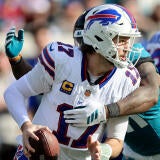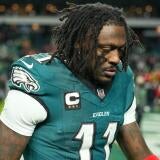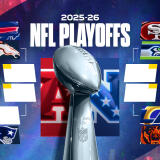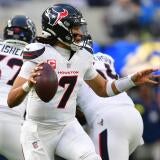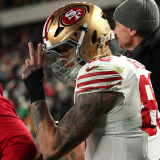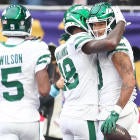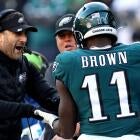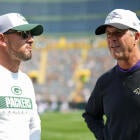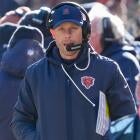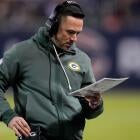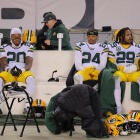Why the Jets' offense has struggled: Is Aaron Rodgers at fault and can Davante Adams help unit improve?
New York is hoping adding Adams to a struggling offense will fix things

Six weeks into the NFL season, there are few units that have been more disappointing than the New York Jets offense. There were high hopes coming into the year for what the Jets could do with Aaron Rodgers under center -- especially after the team remade its offensive line and brought in some new weaponry.
Instead, the offense has been so bad that it got the team's defensive-minded head coach fired. New York is obviously hoping that its acquisition of Davante Adams will kick things into gear beginning this Sunday night against the Pittsburgh Steelers; but it's still worth digging into what exactly has gone wrong to date, why both Robert Saleh (fired) and Nathaniel Hackett (no longer calling plays) lost their gigs, and why -- aside from the fact that they have essentially allowed Rodgers to operate as the general manager since he arrived -- the Jets felt they needed to go out and get Adams.
The Scheme
Unsurprisingly, Hackett was not exactly putting his unit in position to succeed. New York lacks a distinct offensive identity beyond "hey Aaron, go do what you want to do out there." They can't really run the ball and they have certainly struggled to throw it. Their offensive line has looked tentative and slow, and their route distribution is haphazard at best.
They use pre-snap or at-the-snap motion less often than almost any other team (41.1% of snaps, 24th in the league), via Tru Media. They utilize play-action at a below-average rate. They have used just 29 misdirection runs of any kind (split zone, counter, trap, draw, cross/pull lead, etc.) so far this year, the second-fewest in the NFL.
In the pass game, the Jets essentially do not even try to challenge defenses down the field. Among the 186 wide receivers and tight ends who have run 50-plus routes this season, their skill-position players rank 100th (Mike Williams), 124th (Allen Lazard), 128th (Xavier Gipson), 133rd (Garrett Wilson), 162nd (Jeremy Ruckert) and 165th (Tyler Conklin) in average route depth, via Tru Media. (That's how far down the field the receiver gets before hitting his break.)
That has allowed opposing defenses to strangle the short passing game, resulting in the receivers generating an average of just 3.4 yards of separation (23rd in the NFL) and Rodgers having a 16.6% tight-window throw rate is eighth-highest out of 35 quarterbacks who have thrown 50-plus passes, according to NFL.com's NextGen Stats.
Their run scheme just does not generate any openings. Despite facing stacked boxes (eight or more defenders) on only 11.9% of their snaps (third-lowest in the NFL), the Jets have opened up an average of only 0.79 yards before contact per rush. That ranks 30th in the league and ahead of only the Titans and the Patriots.
The Line
Because Rodgers gets rid of the ball so quickly, it's a little bit difficult to measure how effective (or ineffective) the offensive line has been in pass protection. Pressure is as much a quarterback stat as it is an offensive line stat, if not even more of one.
But we do have some grading systems that can take a look at their performance: New York's tackles check in 37th (Tyron Smith), 53rd (Morgan Moses) and 75th (Olu Fashanu) among 79 qualifiers in pass-block grade at Pro Football Focus. They are 30th, 48th and 57th in run-block grade. The guards have actually fared quite well: Alijah Vera-Tucker is fourth and John Simpson sixth out of 77 qualified guards as pass blockers and 31st and 14th in the run game, while center Joe Tippman is 14th out of 40 in pass blocking and eighth among the same group in run blocking.
If you look at the unit overall, though, they rank just 25th in ESPN's pass-block win rate and 28th in run-block win rate. That is not going to get it done.
The Receivers
As previously mentioned, New York's receivers have generated an average of just 3.4 yards of separation on their routes. That checks in 23rd in the NFL. Rodgers throughout his career has been among the best quarterbacks in NFL history at "throwing the receiver open," but even at his peak there was only so much difference that could make when the wideouts themselves don't create larger windows.
The receivers also haven't done a particularly good job at the catch point, with a drop rate over 10% on Rodgers' throws, per PFF. That's sixth-highest among 35 qualifying quarterbacks. And as if all that weren't bad enough, they have struggled after the catch as well: They're one of only nine teams that doesn't have even one player averaging at least 1 yard after catch over expectation, per the NextGen Stats data. Lazard leads the group at 0.9 YACOE.
Wilson is averaging a career-worst 6.0 yards per target. Williams' 8.5 yards per target are his worst since his rookie season, when he saw only 23 passes thrown in his direction. Gipson is at 3.7 yards per target (albeit on only 6 targets), Lazard is at 8.9 (better than last year but worse than three of his four seasons as a regular in Green Bay), Conklin is at 6.4 (7.1 last year) and Ruckert is at 3.2 (career low). None of these guys have been efficient; none of them are creating explosives; most of them are rarely getting open.
The Quarterback
Honestly, this is the biggest thing. Rodgers runs the show, and he has simply not played up to the standard he has established throughout his career nor the level the Jets expected of him coming into this year. Of course, that shouldn't be surprising. He is a 40-year-old quarterback coming off a torn Achilles who spent his offseason flirting with a run for Vice President and visiting Egypt instead of rehabbing and participating in minicamps.
Rodgers has thrown into tight windows at a high rate, as previously mentioned, but he still has the league's 12th-highest expected completion percentage, per NextGen Stats. The problem is he is not meeting those expectations. His -6.7 completion percentage above expected ranks 30th among qualifying quarterbacks. He was at -1.6 the last time we saw him in 2022, but before that he was at +2.8 and +3.4 during his back-to-back MVP seasons. In other words, he is on a significant downward trend.
And that's despite a 7.1 air-yards-per-attempt average that is the second-lowest of his career, via Tru Media. He's also throwing an average of 1.8 yards short of the line to gain, again a career-low mark. And his 12.4% deep pass rate checks in ahead of only four of his previous 14 seasons as the starter.
Rodgers used to be able to extend plays with the best of them, but he can't do that any more. Just 24.4% of his pass attempts have come after 3 or more seconds, via Tru Media. That's the lowest mark among the 11 seasons for which they have complete data, as is his average of 2.56 seconds before throwing the ball. As if to hammer it home even further, his 4.8 yards per scramble are also a career low by more than 1.5 yards. He now resembles a statue in the pocket far more than the dynamic Rodgers of old.
Couple all that with a career-worst 12.4% off-target throw rate, career-worst 4.1% touchdown rate, a 2.3% interception rate and the highest pressure-to-sack ratio for the 11 seasons for which there is complete data, and, well... you get this decrepit Jets offense.
Can Adams alone turn this all around? I wouldn't put it past him, especially considering the pre-established chemistry between him and Rodgers. But there is a whole heck of a lot that needs to be turned around here; more, likely, than one man is capable of turning. It has to start with the guy under center stepping up his game.


